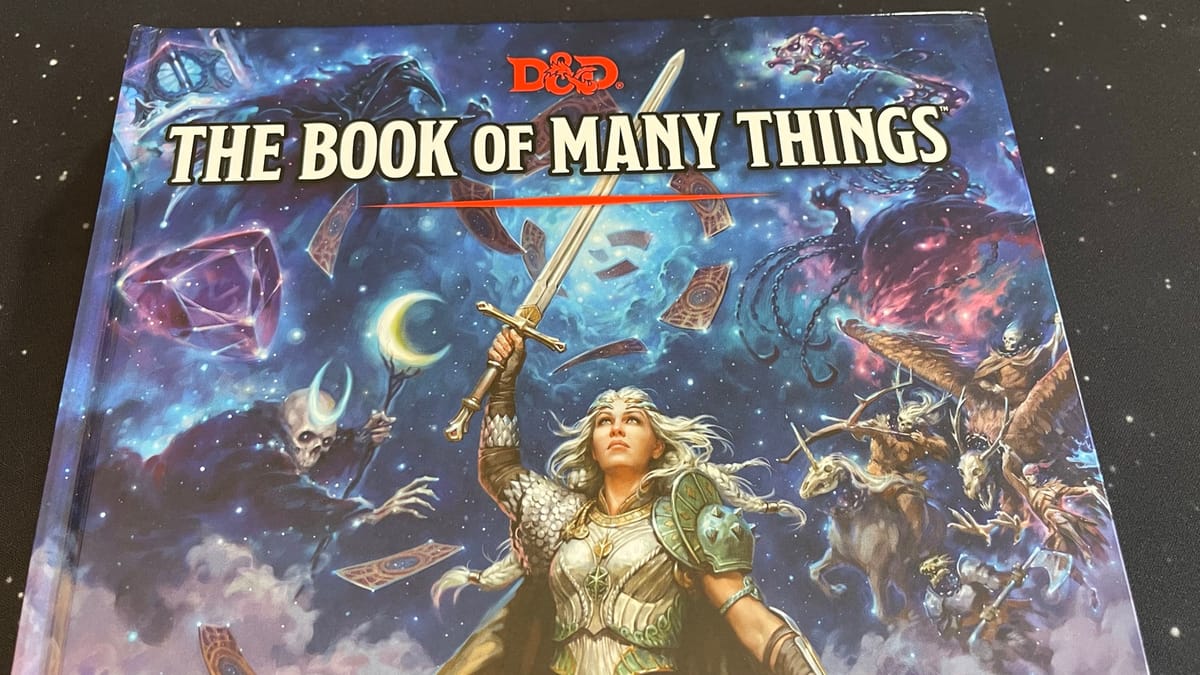
One of the iconic magic items in the D&D multiverse is the Deck of Many Things. As a young DM, it was one of the items that I often considered using in my games. A deck of cards found in the midst of a dragon’s hoard that turns out to have the power to change a life for good or ill with a single draw? Sounds fun! However, it’s one of those items that I would read and consider but never took the risk of including it in my game. It was just too consequential and unpredictable. Even for a DM that didn’t run a very linear campaign, the Deck of Many Things introduced some extreme elements. With one draw from the deck, a character could gain a treasure map, a magic weapon, lose every magic item they have, be banished, or solo fight a very difficult to defeat incarnation of Death. With thirteen or twenty-two game-changing cards in a deck, I loved the idea but feared the consequences.
I suspect that a few of my players over the years would have been willing to take the risk of drawing a card or two from a Deck of Many Things, but unfortunately, I’ve never given them the opportunity. The original Deck of Many Things (and its subsequent incarnations in various editions of D&D) was represented by a standard playing card deck; each type of card standing in for one of the fantastical cards in the game world, so DMs could hand their players an actual stack of playing cards to draw from. But now, just like the Tarokka decks from the Ravenloft setting, there is a customized Deck of Many Things that a DM can hand to their players. The deck comes bundled with the Book of Many Things, which takes what was once less than a page of information in treasure tables of the Dungeon Masters Guide and expands it into about 190 pages chock full of information about the Deck and Deck-related things.
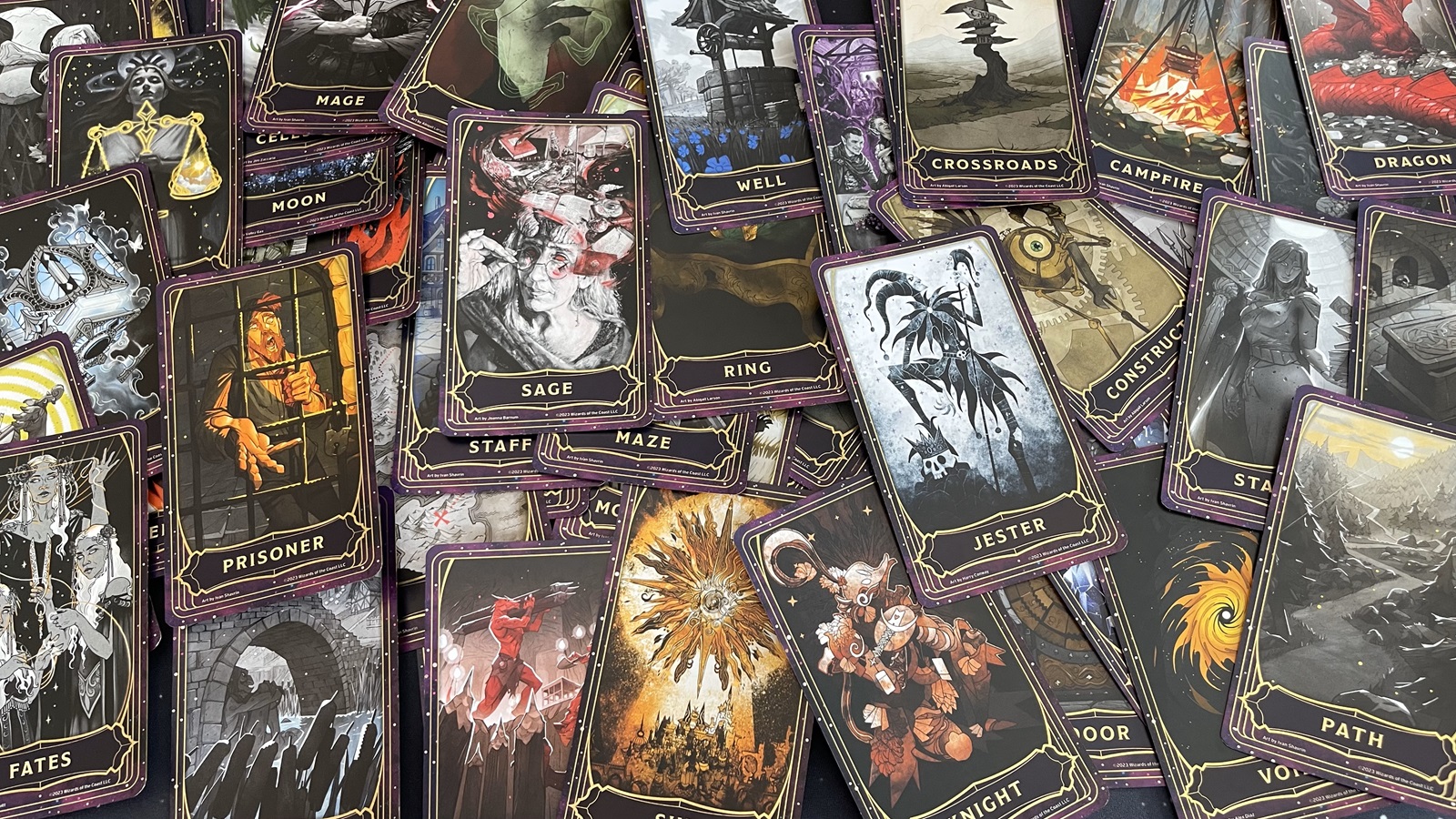
That’s one big pile of cards.
Like many Wizards of the Coast D&D publications, the Book of Many Things comes with a standard cover and an alternate cover. Both covers feature Astaria, the person for whom the first Deck of Many Things was created. The standard cover, by Ekaterina Burmak, shows Astaria standing with a sword raised in front of a starry sky full of references to the deck, and Euryale, the other character from Astaria’s story, gracing the back cover. The alternate cover, by CoupleofKooks, is more stylized, showing Astaria with a Deck floating arrayed in front of her and surrounded by a border of skulls and chains. The alternate cover also shares its art style with the cards in the Deck itself. Overall, both covers look fantastic. The art inside the book is outstanding. Many pictures clearly draw inspiration from the accompanying cards, since the cards are featured in some of the pieces in the book.
The Book of Many Things is divided into twenty-two chapters, each of which is named after one of the cards in the original Deck of Many Things, save two which have been renamed. The renamed cards function as they always have. To make things a little more digestible, the twenty-two chapters have been divided into five sections focusing on Dungeon Master content, player content, new organizations, adventure locations, and monsters and NPCs. The Deck’s history in the D&D lore gets a treatment here, along with the introduction of the original user of the Deck, Astaria, who drops in and leaves notes throughout the book. Many other concepts for the Deck are introduced or fleshed out in this book as well. Among these are the idea that, while there is one original Deck of Many Things, there are many copies out there. Additionally, while the original Deck had twenty-two cards, since its creation more cards have been added. With those basic ideas in mind readers can venture further into the book.
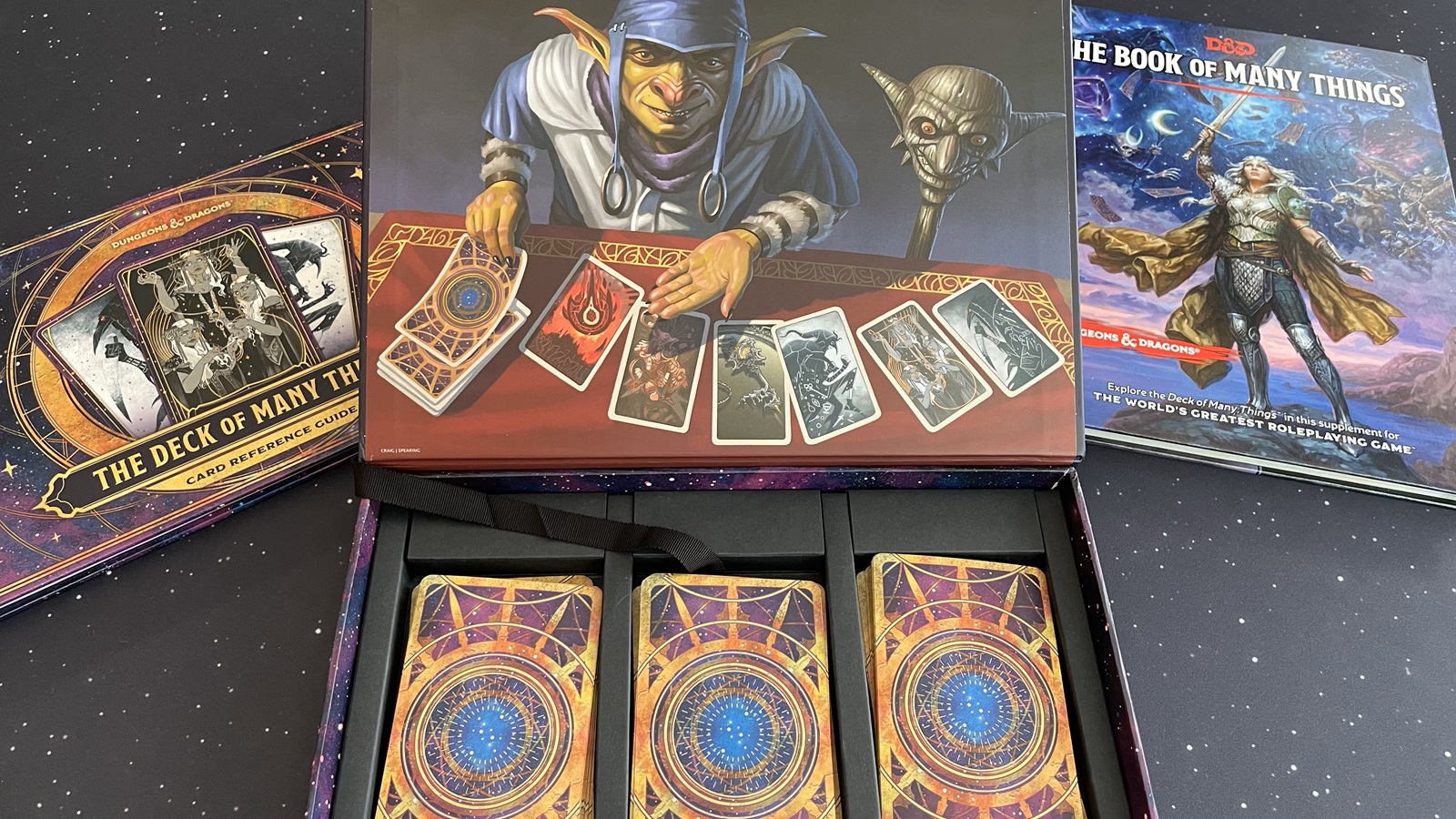
The set contains two books and a box full of cards.
The first chapter is really just a five page introduction which includes a brief history of the Deck of Many Things in D&D rules throughout the years and editions. I often find these histories interesting, so learning that a different version of the deck appeared in Dragon magazine in 1983, and again in 1989, was super fun. But for those that don’t find that kind of thing worthwhile, it’s just a couple of columns of text and then on into the meat of the book. The structure of the book, with the chapters themed after cards, breaks down a bit in application. As you read through the book you’ll find things scattered about that could have been grouped together. When trying to reference something specific in the book, it might take a bit of flipping around to find. Fortunately, there is an index for magic items and one for monsters, so if you can remember where the indices for those are, then you are good to go. But anything else, you’ll just have to remember what chapter it was in. That might be more of a problem for players, since the small amount of player information seems to be a little less structured than the DMs stuff. Players don’t have that much in this book and it could have been consolidated into one chapter, except for the way they themed the chapters prevents this.
The introductory chapter is titled after the card Fool and is the first of five chapters ostensibly dedicated to filling out the DM’s toolbox. As a long-time DM, I always eagerly dive into these sections of the books looking for any nuggets that I can use in my own games. In this case, I was not disappointed! Chapter two, Key, is indispensable, as it gives a DM ways to introduce the Deck into their game (other than in a dragon’s hoard), different ways to construct the deck, and different ways the deck can be used other than originally intended. Critically, this chapter explains why there are forty-four more cards in the deck and gives construction options to help DMs incorporate these new cards.
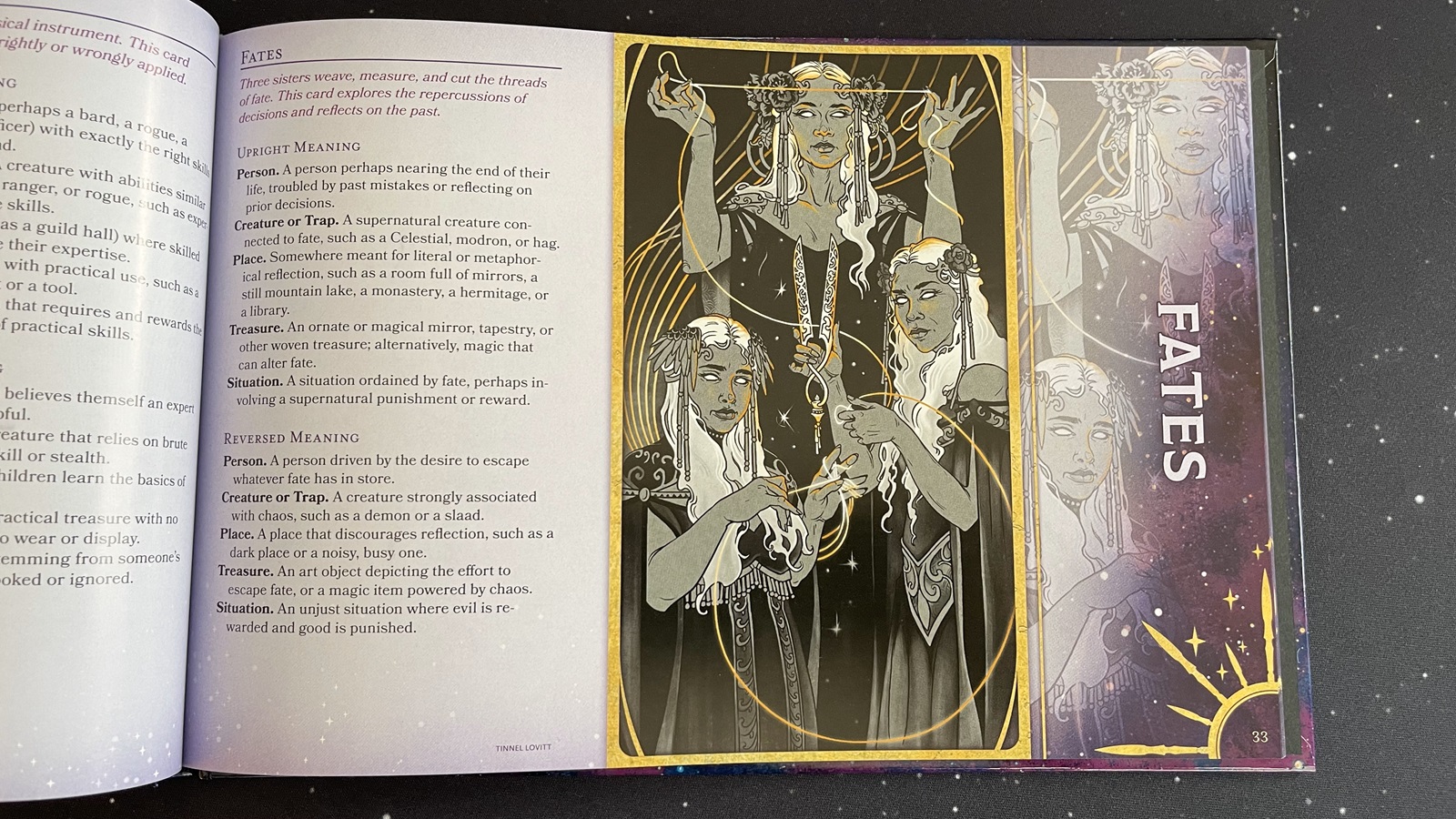
The guidebook has an image of each card along with the written information.
There are some interesting ideas in here that entire campaigns can be built around. For instance, the book introduces the idea that a person who contributes a card to a deck could become immortal as long as their card remains in that deck. I immediately thought about having the villain in a campaign be such an immortal who, much like a lich with a phylactery, cannot be destroyed until the card is found and removed from the deck. Chapter three, Balance, gives the DM options for using the Deck in lieu of dice to produce random events such as encounters, or using it to create encounters. Puzzle, chapter four, presents options for using the deck to create puzzles, traps and riddles. While the puzzles use the cards themselves, the traps and riddles are simply inspired by the cards. The ideas are solid and useful for any campaign. Chapter five, Gem, rounds out the DM’s toolbox with a brief discussion of handling player character wealth accumulation in your games and a selection of twenty-two magic items themed after the Deck. While not every item is amazing, there are plenty of items that DMs will want to incorporate into their games.
Those aren’t the only magic items in the book. Several chapters include new magic items. Notably, the Deck of Many More Things (emphasis on the “More”) is described, spelling out the traits of the forty-four additional cards. These new cards contain more beneficial traits than harmful and a DM can pick and choose which to use. There are some inspired magic items and I liked the inclusion of some new charms (a potentially overlooked option described in the DMG). The twenty-two charms, more than triple the seven suggested in the DMG, really breathe some life into that option. Throughout the chapters players can find character development prompts for their characters, two new arcane character background options, a new feat, three new spells and a few other ideas. Generally, all of the ideas are good and most players will find them useful. As with much of the book, the backgrounds are inspired by the Deck and can bring some interesting roleplay ideas to character creation.
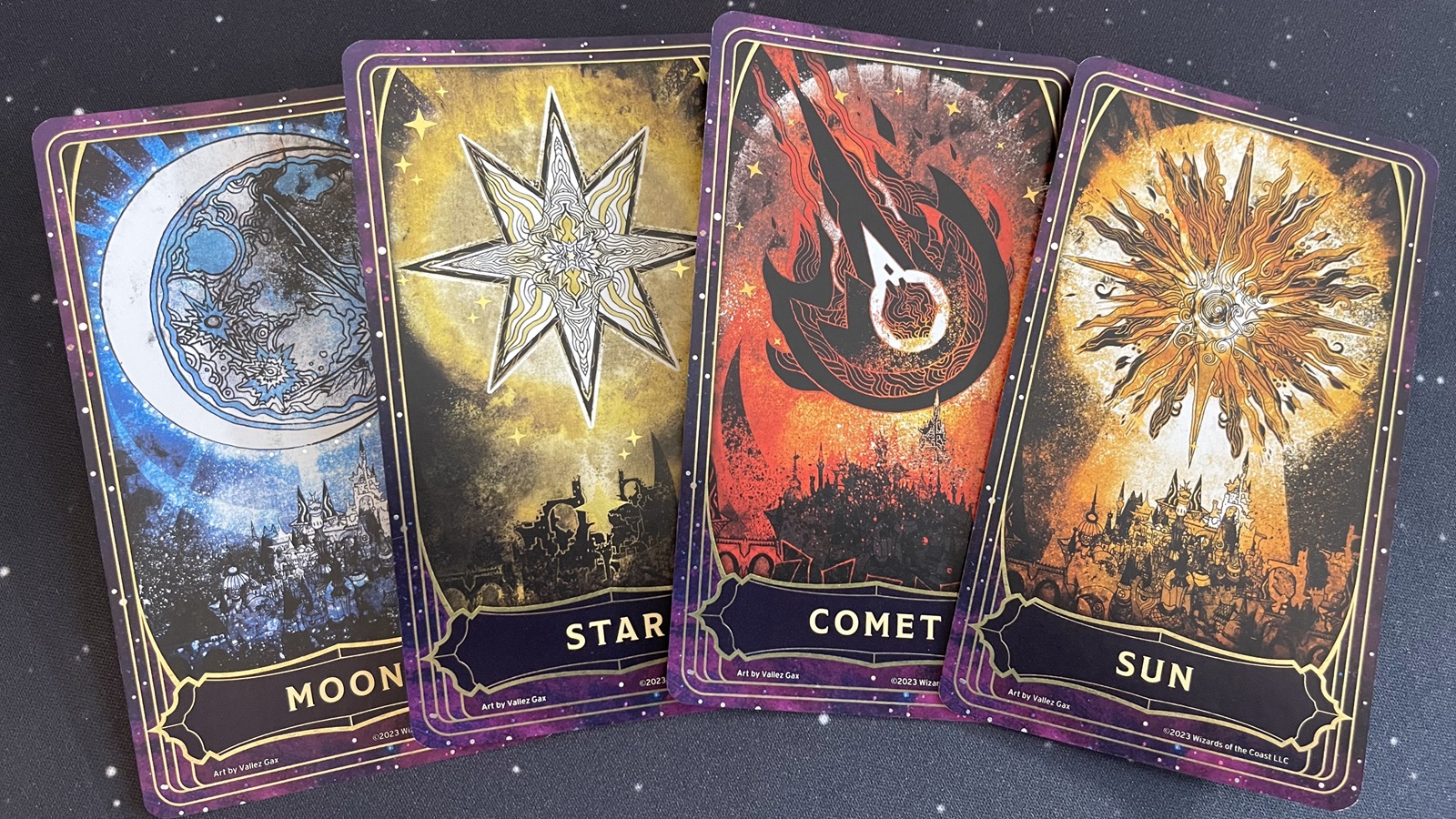
These four cards appear to show celestial events over the same town.
There are several new organizations introduced in the book. Again, they are inspired by or even related to the Deck, but all of them can be used without referencing the Deck. Tied directly to the Deck are the Solar Bastion organization and the Grim Harrow. The Solar Bastion is dedicated to finding, monitoring, and executing damage control on all the incarnations of the Deck. They provide DMs with a beneficial organization that ties directly to the Deck in their campaign. Complete with a base and stat blocks for typical members, it’s a useful good-aligned organization and ties in well with the Deck. On the other hand is the Grim Harrow. Composed of undead that have been trapped by the Deck, they roam the multiverse searching for copies of the Deck to destroy it. While they are directly tied to the Deck, it’s entirely possible for a DM to integrate them into a world and have them run afoul of the PCs without ever involving an actual Deck.
The Moonstalkers and the Heralds of the Comet are two organizations of bad guys that can be dropped into any campaign or game world they are inspired by, but not connected to the Deck. The Moonstalkers, essentially a lycanthrope thieves guild, can operate in any big city and be a motivating force for bad things to happen. They are willing to do the dirtiest of dirty work and are presented with a mapped out guildhall. The Heralds of the Comet are an apocalyptic organization dedicated to ensuring that an apocalypse happens. They have set their sights on the Deck of Many Things as the instrument that will bring about the destruction of all things, but that’s easily ignored by a DM that has other plans.
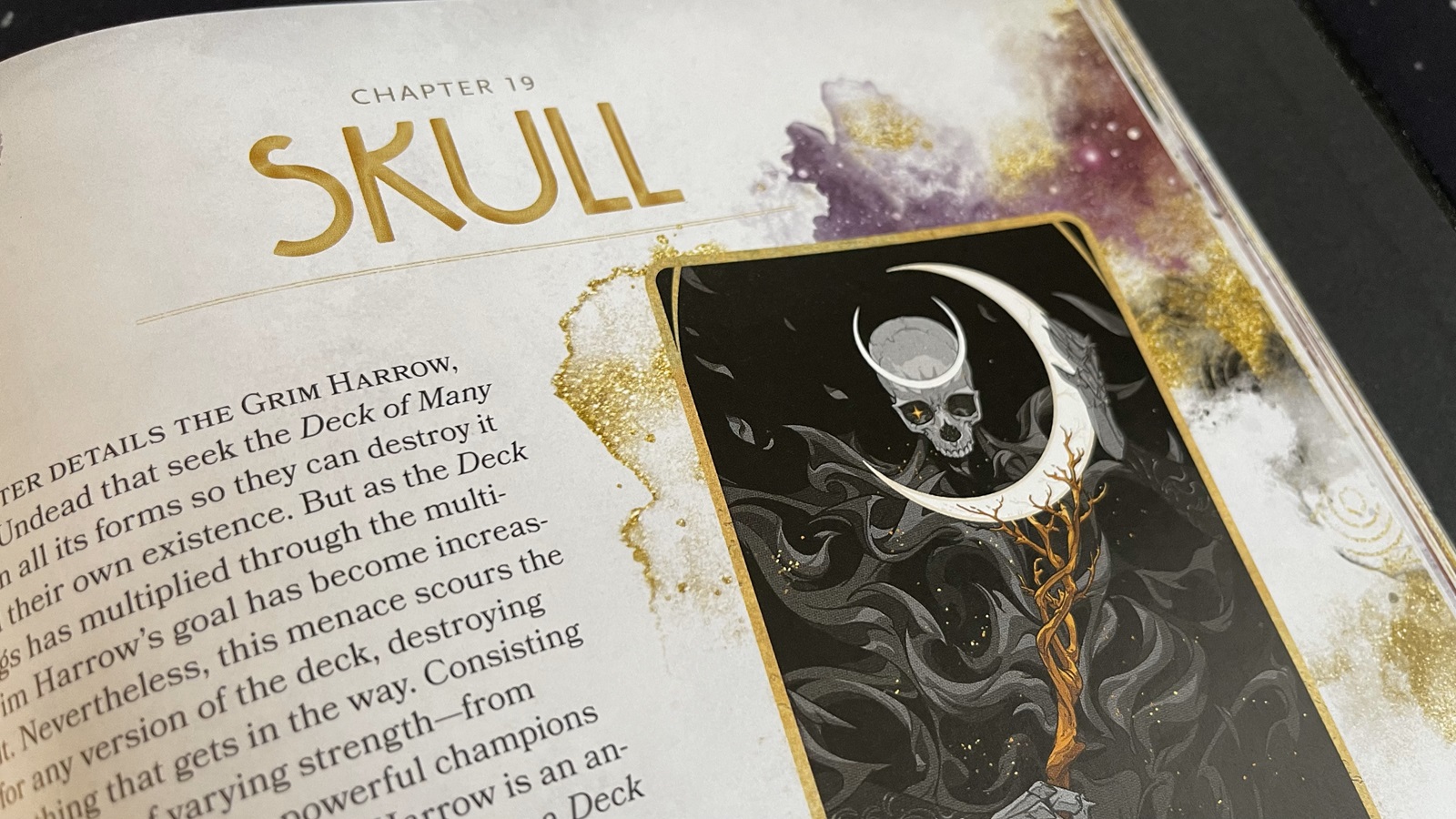
Each chapter is associated with a card from the original Deck of Many Things.
There are a number of cards in the Deck of Many Things that can result in things manifesting in the world. This book describes different ways that some of those cards can play out, other than a creature just snapping into existence when the card is drawn. NPCs are created as a result of drawing the cards the Knight and the Rogue. For the Rogue, the book suggests ways to incorporate the appearance of the rogue into the ongoing story along with motivations and provides stat blocks for rogues of different challenge ratings allowing for a scaled threat. The Veiled Presence, a Challenge Rating 21 celestial rogue is very cool – woe to the PC that draws that card. The Knight card produces an ally character. The book provides a discussion on different types of allies that can be the knight and it throws in a construct called deck defender that looks like an origami knight made from a card. For the Keep card that provides a keep, you get Harrowhall, a mini adventure that boils down to a dungeon clearing process. Once the keep is cleared, the PCs are the proud owners of a keep. The Donjon card throws the victim into a dungeon and for that, we are provided with a spherical prison mapped out and detailed. While drawing the Ruin card usually means ruin to the character, they’ve reimagined it to provide an actual ruin. The ruins produced by the Ruin card are essentially a dungeon that ends with a Deck of Many Things in a dragon’s hoard. It’s a nice mini-adventure with every creature pulled from the Monster Manual, so no stat blocks. There’s a section on how to handle the Void card and where the person’s soul could be located, a demiplane called the House of Cards. The House of Cards, a dungeon made out of huge cards from the Deck, is yet another mini-adventure themed around rescuing the trapped PC. The Skull card results in recruiting members of the Grim Harrow discussed earlier. Their entry includes the demi-plane they spawn on called the Gardens of Decay and stats for the three Grim Champions that lead the Grim Harrow.
Scattered throughout the book DMs will find a trove of useful ideas for incorporation in their games. There is a zodiac inspired by the Deck which gives a description of twenty-two constellations with associated omens. For those DMs so inspired to use the zodiac, parts of it, or create their own, the book explores observatories and how to incorporate them into your world. There’s a Fey market that travels as a flying train pulled by a dragon. The market comes with a general description and a list of vendors and products. Products include a creative Fey Fruit that provides magical effects on consumption (in table form). There is also a goblin fortune teller named Oddlewin that uses nine cards from the Deck. As a traveling fair, this location can be dropped directly into the middle of any campaign. Among the dozens of new monsters throughout the book, three unique fiends are introduced, a demon (which comes with its own layer of the Abyss), a devil, and a yugoloth. The last chapter of the book focuses on the characters of Astaria and Euryale, presenting their story, suggesting adventure hooks and stat blocks.
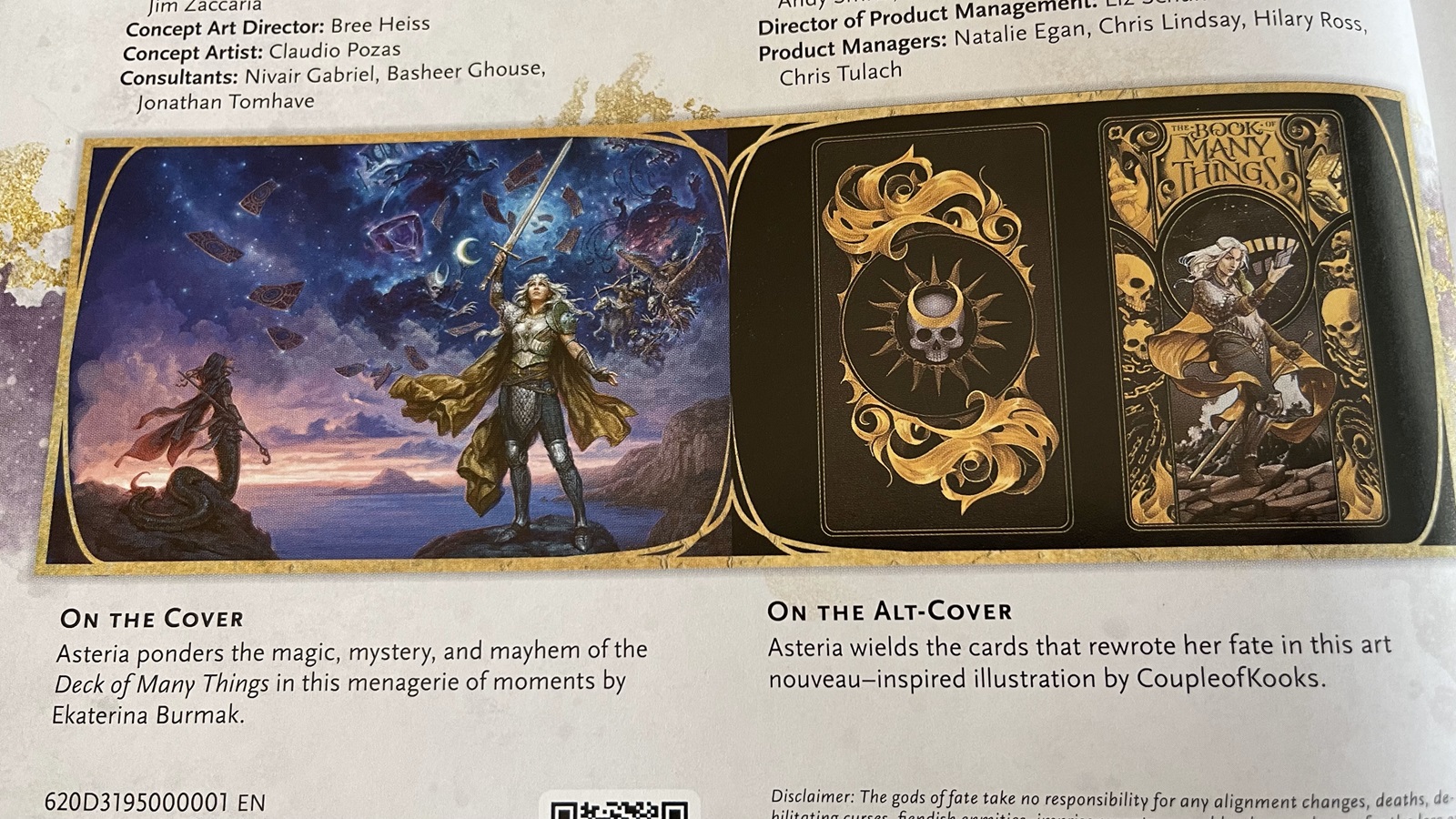
A comparison and description of the two available covers.
The Deck of Many Things bundled with the Book comes in a handsome purple and gold cardboard box in a slip cover. The box lid hinges open to reveal on the inside of the cover the image of a goblin fortune teller with cards spread in front of him. The deck is split into three compartments in an insert, covered by an eighty page card reference guide. Of note – there are sixty-six cards in this deck, more on that later. The cards have a gold, purple, and blue wheel pattern on the back, gilded edges, and are about the size of an index card (roughly 3 by 5 inches or 7.5 by 12.5 cm). On the face, each has its name on the bottom under an excellent piece of artwork illustrating the card and bringing it to life. The cards are partially foiled with a shiny gold frame around the title and artwork and foil flashes incorporated into each piece of art.
The deck has a unified theme and look despite being created by nearly a dozen different talented artists. Interestingly, some of the artwork shows relationships between the cards, such as the Throne and Ruin cards which have the same sword and crown in them, or the Moon, Star, Sun, and Comet cards which appear to have the same town beneath their celestial namesakes. The design from the back of the cards subtly makes its way into some of the card artwork and at least two, Maze and Statue, in a meta twist, have representations of the cards themselves in their artwork. The card quality is pretty good, about the thickness of a standard trading card game, but with larger size. I think that size has a little cost; my cards came slightly warped, but not so bad that it matters. All in all, these are some fantastic cards with impressive artwork.
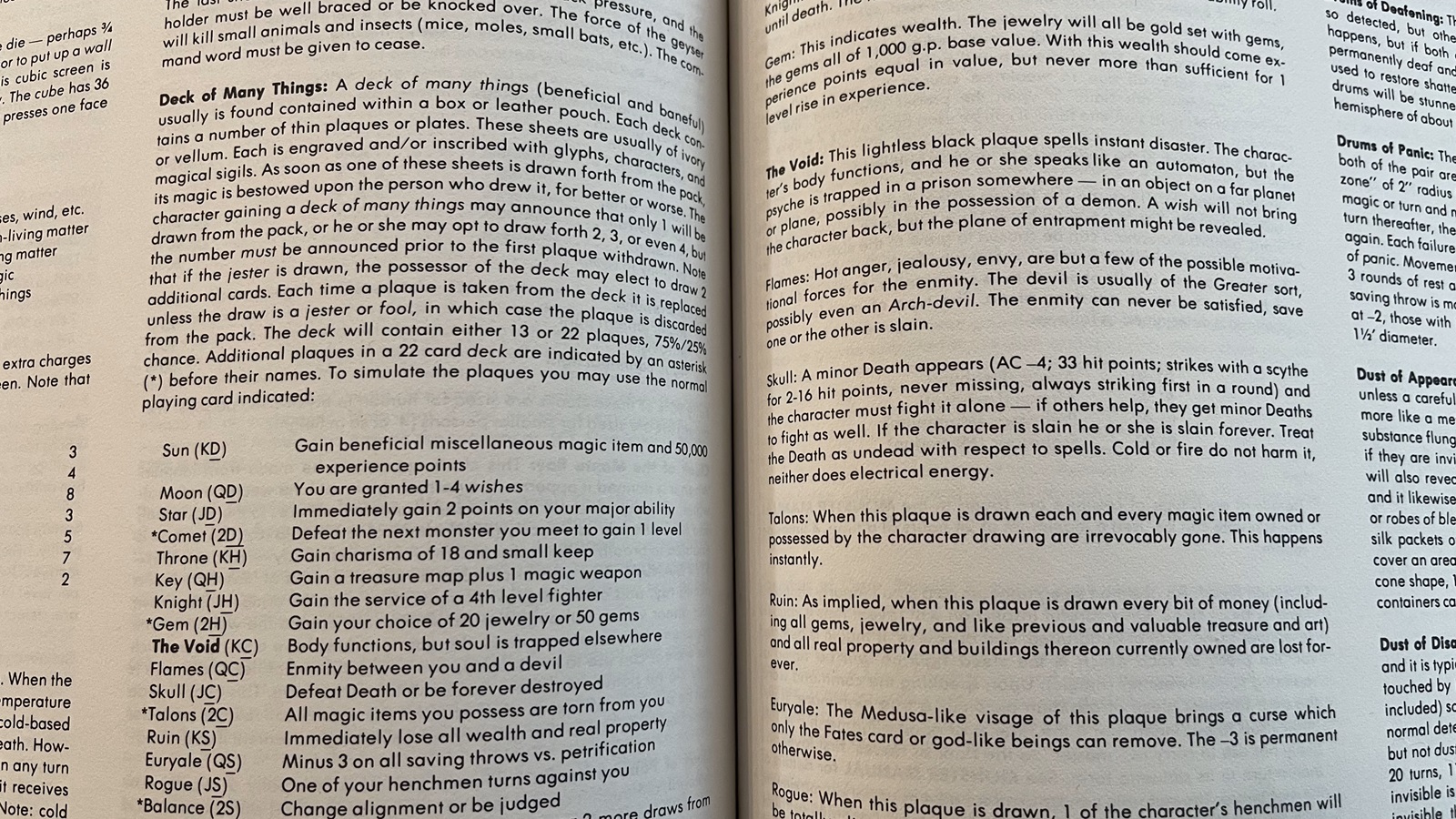
A view of the first edition Deck of Many Things.
The accompanying guidebook is impressive. The guide dives into how to use the Deck for divination. With the artwork and size of the cards, they make great tarot-like cards and would be an excellent prop for a divination session with an NPC. This section helps with layouts and how to interpret the cards. You also get suggestions on using the deck to create random adventures. It’s a pretty creative way to use the deck, and a DM can use it in or out of play. Finally, there are sixty-six pages detailing each card. The pages feature the card art and describe what the cards could mean in a divination or adventure layout in upright or inverted positions. It’s an inspired guide and well put together.
The Book of Many Things
Excellent
The book is overflowing with great ideas for DMs and has a few juicy nuggets for players as well. The cards are outstanding in look and feel, they are an excellent prop to add immersion to the story. The reference guide is both informative and useful. Every part of this should find a use at someone's game table. The only negatives I have for this is the chopped up order that the chapter structure creates and the limited resources for players. All in all, this is an outstanding addition to the Dungeons & Dragons fifth edition set.
Pros
- Overflowing with great ideas
- Cards are a great physical prop
- Beautiful artwork throughout
Cons
- Not much content for players
- Structure makes it hard to find things
